Transmission line towers
 |
A well known object In the
area around Rotterdam transmission line towers are a
standard feature of the landscape.
There are several power-stations and switching
stations in the area (Dordrecht, Maasvlakte, Krimpen a/d
IJssel) and a lot of heavy industry (Nedstaal,
Aluchemie).
The Dutch landscape is flat and they stand out nicely.
They soar to amazing heights where the wires cross the
river.
|
| Useful for urban adventure ? Access
looks easy at first sight. Becuse of the high maintenance
needs these towers have always a
"user-friendly" acces route. Some transmission
line towers have ladders running inside their iron
sheleton. Others have spikes running along one of the
corners.
But in fact they are too
dangerous to climb. It's also illegal and possibly
lethal.
|
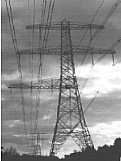 |
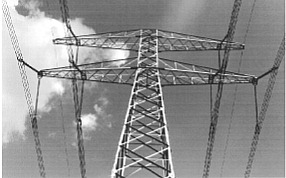 |
But of course some people have climbed
them anyway ...
For some people they are attractive targets. Even for
"normal" people. I've asked around in my circle of
acquaintances and see what I got:
- One of the members of our choir has climbed them as a
child.
- One of my bosses has climbed them as a child. He says
that they got a nice view of the landscape. And they
found out that the top wire carries no power.
My boss described it very graphically, so
imagine the following situation:
- My boss and his friend have
climbed to the top of the tower.
- My boss notices that the
power cables are hung from insulators.
- Notices that the top wire
has no insulators.
- Touching the top wire with
his hand: "Hey, cool, it doesn't carry any
current!"
After this discovery they made
plans to make a cable car from an old bicycle wheel and
to cross the river hanging from the top wire. But they
never put it into practice.
It seems that people grow out of this as they get older.
Usually they turn to other nerve-wrecking activities. My
choir-colleague became a professional photographer. And my boss
became a network manager.
And some people have even taken
pictures ...
The brother of a colleague of mine has climbed transmission
line towers and building cranes. I exchanged some short e-mails
with him and talked to him over the phone. He acted as if it
wasn't such a big deal. Let me quote him:
- What could I tell you? It works like this: you climb up
and then you clim down again.
- I didn't use any special techniques. I did it UNSECURED
and UNINSURED ("ongezekerd en onverzekerd").
- At one time I hung a pirate's flag (skull and bones) from
the top-wire. But when I came back a few days later it
was gone.
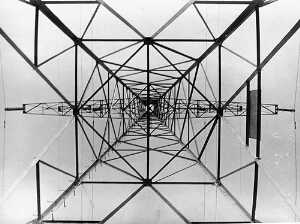
Looking up at the 110kV transmission line tower near Geleen. On
the right you see the backside of a small sign. Usually these say
"Mortal danger".
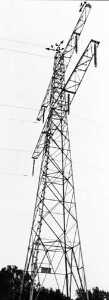
Looking from the side. The small arrows and the numbers show the
different viewing directions. You can recognize them in the
following pictures. Also notice the spikes along one of the
corners leading all the way up.
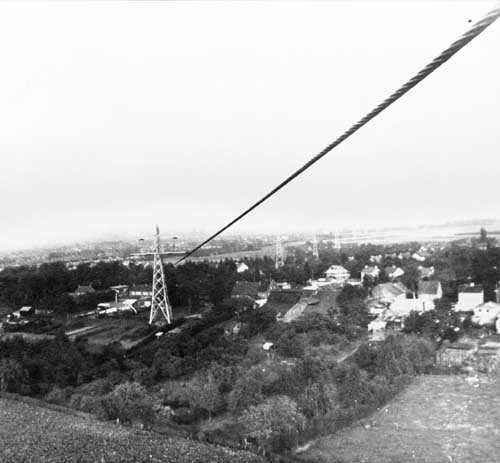
Looking at the next mast form the top (view number 4). The wire
you see is the top (zero, lightning-conductor) cable. You also
get a nice view of the undulating countryside around Geleen. It's
in Limburg, the southernmost province of The Netherlands.
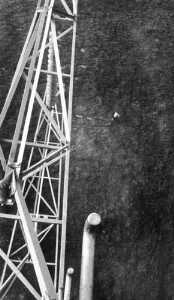
Looking down from the center (view number 1). You can barely see
Ed's brother Ton and his bicycle standing in the grass below. Ed
was 18 at the time and Ton was 16. Their mother didn't really
approve these activities.
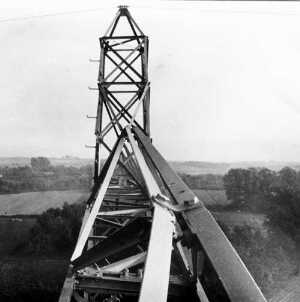
Looking towards the center from the end of the top boom (view
number 3). Notice the spikes again.
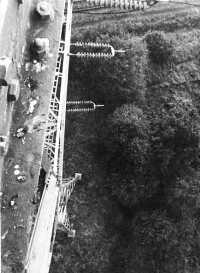
And finally a look down along the center. It really is high!
What are the dangers ?
The official advice of the electricity company is: DON'T CLIMB
THEM. But I wanted a more specific decription of the dangers and
I visited the library of the Ministry of Social Affairs. This
library has a lot of safety literature. I give you a quick
overview of what I found. I cannot guarantee the accuracy
however! Correct me if I'm wrong please. The firemen's and
policemen's guidelines say: Stay away from live wires. Keep a
minimum distance of 5 to 10 meters. But even more detailed
instructions exist.
The "basic-distance" is the theoretical safe
distance from a live wire. However if you're climbing or working
in a transmission tower you cannot control your distance from the
wires very precisely. Also the tower and the wires are swinging
in the wind.
So in these situations you have to maintain the minimal
"boundary distance" from the wires. If you have tools
in your hands or if you carry things you have to look out for the
extra "reach" this gives you - and for the added
exposure.
If you climb up using a ladder you should not add just 1 m to
the "basic distance", but 1 ,35 meters. If you use the
spikes ("klimpennen") you have to add 1,60 m. So then
the boundary distance is even larger than indicated in the table
below.
Source: Notitie ter toelichting van het aspect "veilige
afstand" bij de werkzaamheden in de hoogspanningsaanleg,
Oktober 1987, N.V. KEMA / VDEN
| Nominal voltage |
Maximum voltage |
Basic distance |
Boundary distance |
| 50 kV |
72,5 kV |
0,70 m |
1,70 m |
| 110 kV |
123 kV |
1,20 m |
2,20 m |
| 150 kV |
170 kV |
1,60 m |
2,60 m |
| 220 kV |
245 kV |
2,60 m |
3,60 m |
| 380 kV |
420 kv |
3,60 m |
4,60 m |
You don't notice that you're too close until it's too late.
People have got killed even by touching cables that were NOT
carrying current. However the current in neighboring cables
produced an induction current in the unused cable. These
induction voltages can get as high as 10 kV. High enough to kill.
Less people get killed by electrocution than by falling from
the tower. The towers can be anywhere between 40 m to 160 m high.
Falls are caused by mis-stepping, slipping, tripping over
something, becoming sick, getting a non-lethal electric shock,
being hit by a dropped object. The conclusion is that you have to
be secured to the tower at any time. You have to be secured if
you work higher than 2,5 meters.
Never use a harness that is secured only around the chest.
This can cause a painful death after hanging only 5 minutes.
Allways use a harness that supports your weight in the hip-area.
Most of the lethal accidents occur on the descent from the
tower. Several "human factors" combine to increase the
danger:
- work is finished, attention is diminshed
- in contrast to the ascent you cannot see where you're
going and you can't see very well where you put your feet
- you don't allways have both hands free to hold yourself
- you are more tired after finishing the job
BTW: This also applies to rock-climbing and alpine climbing.
20% of all accidents is due to breakage of the support
20% are due to mechanical instabilities of the support
30% are due to the worker unclipping his harness from the
support, then changing his position while being unsecured
People over 40 years of age suffer significantly less
accidents than younger people. Are they more careful? Or do they
move to less risky jobs? There is not enough data to support
either hypothesis.
Proximity-detectors for "life" power-cables exist
but they cannot tell you if you'e still within a safe distance
from a cable.
Back to: Buildering, Home
© 1999 Ed Stevenhagen, Petr Kazil - 19 April 1999








